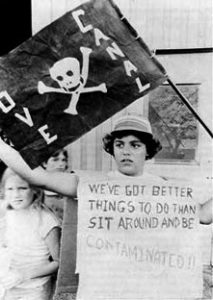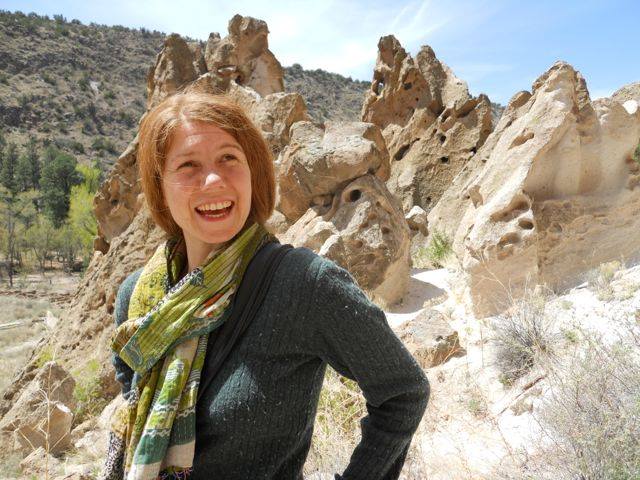
This week in nonviolent history commemorates a turning point in the long struggle to demand justice for the residents of Love Canal, a residential community in upstate New York that was situated on top of a leaking toxic waste dump. On August 2nd, 1978, State Health Commissioner Robert Whalen issued a state of emergency ordering the immediate closure of the nearby 99th Street School (where children played in puddles of leaking toxins) and the evacuation and relocation some of the residents. Two years later, after serious campaigning by the remainder of the residents, President Jimmy Carter issued a National Emergency, which relocated the rest of the residents. Love Canal remains a super-fund site to this day.
The story begins in the 1890s, when developer William T. Love planned to dig a canal between the Niagara River and Lake Erie, and situate a “dream community” named Model City along it. Love dug about a mile of the canal, built a few houses and streets along it, and then the financial crash of 1893 dashed his dreams. In the early days, the children in the area used to swim in the river in the summer, and skate on it in the winter, but in the 1920s, the Niagara Municipal Department began to use the pit for dumping refuse. In the 1940s, Hooker Chemical used Love Canal for their toxic wastes.
In 1952, Hooker Chemical deeded the site to the Niagara Falls School Board for a dollar. In the “sales” agreement, Hooker Chemical included a seventeen-line section releasing them from all legal obligations. The Niagara Falls School Board signed, and began to develop the site for a school. During construction, the containment walls were breached, and toxins began to seep out. In 1955, a twenty-five foot area crumbled, exposing toxic chemical drums, which then filled with water during rainstorms. A few years later, low-income and single unit dwellings were built, breaching more of the containment walls.
By 1978, around 800 single-family homes and 240 low-income apartments had been built, and reporter Michael Brown described Love Canal as a “public health time bomb”. His door-to-door investigations discovered frequent cases of birth defects and many anomalies such as enlarged feet, heads, hands, and legs. On his advice, local residents created a protest group, led by resident Karen Schroeder, whose daughter had nearly a dozen birth defects. Michael Brown’s journalism also alerted Lois Brown, who had moved to Love Canal, enrolled her son in the elementary school in September 1977, and by December, found her son seriously ill, having developed epilepsy, asthma, a urinary tract infection, and had a low white blood cell count – all symptoms that were eventually proven to be associated with his exposure to the leaking chemical waste.
Wikipedia reports, “Gibbs began speaking with her neighbors, walking door-to-door to collect people’s information and their stories. At the same time, angered residents formed a tax-and-mortgage protest group and organized a demonstration during which they collected mortgage statements and burned them because of their frustration at the depreciated value of their homes due to the presence of chemicals.”
New York State Health Commission Robert Whalen declared a state of emergency, which ordered the relocation of residents deemed “high-risk”, including families of pregnant women and children under the age of two. However, the state refused to relocate fifty-four families who lived on the edges of the contaminated area. Using street protests, prayer vigils and a march to the state capital while carrying empty children’s coffins on Mother’s Day to represent birth defects and miscarriages from toxic exposure, the residents’ continued to take action. They picketed near the canal every single day for weeks during the cold winter months. Then came the final, decisive action.
In May 1980, residents nonviolently detained two EPA officials for six hours at the Love Canal Homeowners’ Association offices, which were located in the 99th Street School building, demanding immediate evacuation for the rest of the Love Canal residents. President Carter responded to their requests by declaring a National Emergency two days later – one of the few times the National Emergency has been used for toxin-related health risks. This provided the state with enough funding to the relocation of the rest of the Love Canal residents. In later lawsuits, Hooker Chemical was found financially responsible for the clean up of toxic waste.
It was a victory, but a tragic one. Nothing could bring back the health and the lives of the people and children affected by the contamination. Their actions, however, forced the state and chemical company to condemn the Love Canal, saving lives of countless further residents. The Love Canal Campaign raised nationwide awareness about the health hazards of chemical wastes and triggered a cascade of other lawsuits, campaigns, and actions around similar issues. It is a landmark campaign by ordinary, extraordinary citizens who decided the abuse of their children and their health would end with them.
Learn more: https://en.wikipedia.org/wiki/Love_Canal
____________
This article is from Rivera Sun’s book of nonviolent histories that have made our world. Click here for more information.
______________________________________

Rivera Sun is a change-maker, a cultural creative, a protest novelist, and an advocate for nonviolence and social justice. She’s a love-based revolutionary and the author of The Dandelion Insurrection, The Way Between and ten other fiction, non-fiction and poetry books. Her essays and writings are syndicated by Peace Voice, and have appeared in over a hundred journals nationwide. Rivera Sun speaks and facilitates workshops in strategy for nonviolent change across the country and around the world. She connects the dots between the issues, shares solutionary ideas, and inspires people to step up to the challenge of being a part of the story of change in our times. www.riverasun.com